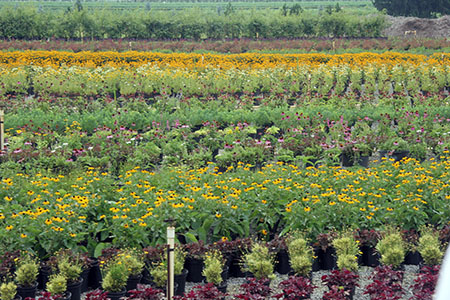Echinacea
Coneflowers (Echinacea spp.) are herbaceous perennials with large daisy-like flowers. There are nine species of coneflower and all are native to central or eastern North America. Purple coneflower (E. purpurea), a well-known garden flower, is extensively cultivated in nurseries. This hardy ornamental is commonly planted in both home and commercial landscapes. Coneflowers are also effective, long-lasting cut flowers.
Marketing
 Echinacea for ornamental use may be produced for retail markets including garden centers, landscape nurseries and farmers markets. Echinacea plants may be wholesaled to other nurserymen, landscapers, or retailers. Cut flowers for floral arrangements could be marketed to wholesale and retail florists, and at farmers markets. Roots and plant material for medicinal/dietary uses are generally marketed to herbalists, manufacturers, distributors, and pharmaceutical companies. Echinacea is sold in various forms, including teas, ointments, pills, tinctures, creams, and powders. Most dealers will not enter into a contract with an inexperienced grower before seeing a sample of what the grower can produce. Buyers may also require laboratory tests for purity. Growers in other states have indicated that it can take up to 10 seasons to secure a contract.
Echinacea for ornamental use may be produced for retail markets including garden centers, landscape nurseries and farmers markets. Echinacea plants may be wholesaled to other nurserymen, landscapers, or retailers. Cut flowers for floral arrangements could be marketed to wholesale and retail florists, and at farmers markets. Roots and plant material for medicinal/dietary uses are generally marketed to herbalists, manufacturers, distributors, and pharmaceutical companies. Echinacea is sold in various forms, including teas, ointments, pills, tinctures, creams, and powders. Most dealers will not enter into a contract with an inexperienced grower before seeing a sample of what the grower can produce. Buyers may also require laboratory tests for purity. Growers in other states have indicated that it can take up to 10 seasons to secure a contract.
Production
 Seed germination in echinacea species can be difficult, so direct field-seeded crops do not usually result in adequate crop stands. Seeds are generally pretreated (stratified) to relieve seed dormancy. Stratification involves holding seeds in a moist substrate at approximately 40 degrees F (4 degrees C) for one to five weeks. Use of transplants results in more satisfactory crop stands. Transplants may be purchased ready for field planting, or grower may choose to finish their own transplants under protected cultivation systems from seeds or plugs purchased from a plug production specialist. Ornamental echinacea plants produced for the retail market are usually produced in 4-inch to 1-gallon containers. Plants for the landscape trade are usually produced in 1- to 5-gallon containers. Plants produced for the retail market are usually transplanted into the finished container from plugs purchased from a wholesale plug producer. Plugs may be produced by the grower for seed cultivars, but vegetatively produced hybrids are patented and produced from tissue culture, so they are purchased as plugs. It is common to produce plants in the greenhouse from late winter transplants for spring sales along with other bedding plants.
Seed germination in echinacea species can be difficult, so direct field-seeded crops do not usually result in adequate crop stands. Seeds are generally pretreated (stratified) to relieve seed dormancy. Stratification involves holding seeds in a moist substrate at approximately 40 degrees F (4 degrees C) for one to five weeks. Use of transplants results in more satisfactory crop stands. Transplants may be purchased ready for field planting, or grower may choose to finish their own transplants under protected cultivation systems from seeds or plugs purchased from a plug production specialist. Ornamental echinacea plants produced for the retail market are usually produced in 4-inch to 1-gallon containers. Plants for the landscape trade are usually produced in 1- to 5-gallon containers. Plants produced for the retail market are usually transplanted into the finished container from plugs purchased from a wholesale plug producer. Plugs may be produced by the grower for seed cultivars, but vegetatively produced hybrids are patented and produced from tissue culture, so they are purchased as plugs. It is common to produce plants in the greenhouse from late winter transplants for spring sales along with other bedding plants.

